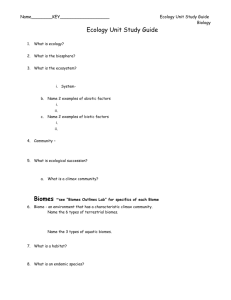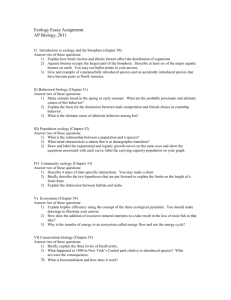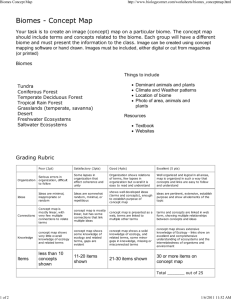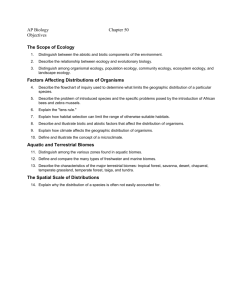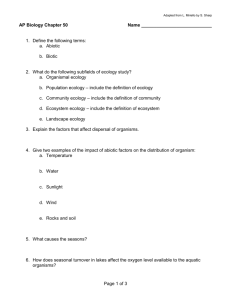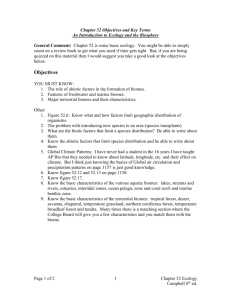Ecology notes chapter 52
advertisement
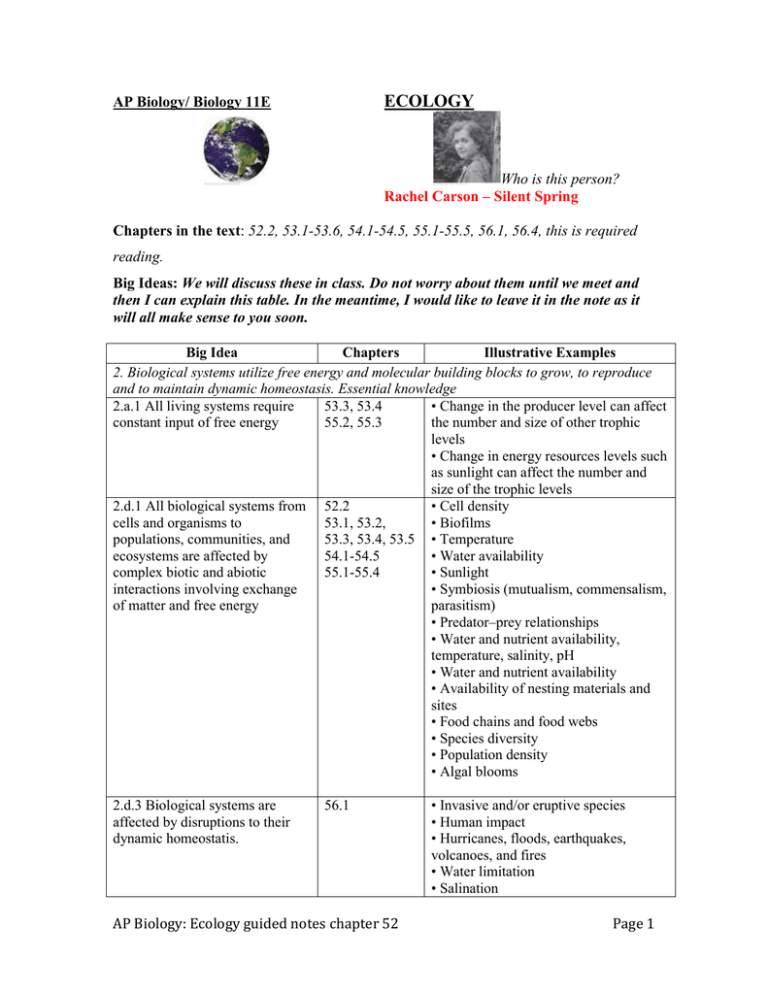
ECOLOGY AP Biology/ Biology 11E Who is this person? Rachel Carson – Silent Spring Chapters in the text: 52.2, 53.1-53.6, 54.1-54.5, 55.1-55.5, 56.1, 56.4, this is required reading. Big Ideas: We will discuss these in class. Do not worry about them until we meet and then I can explain this table. In the meantime, I would like to leave it in the note as it will all make sense to you soon. Big Idea Chapters Illustrative Examples 2. Biological systems utilize free energy and molecular building blocks to grow, to reproduce and to maintain dynamic homeostasis. Essential knowledge 2.a.1 All living systems require 53.3, 53.4 • Change in the producer level can affect constant input of free energy 55.2, 55.3 the number and size of other trophic levels • Change in energy resources levels such as sunlight can affect the number and size of the trophic levels 2.d.1 All biological systems from 52.2 • Cell density cells and organisms to 53.1, 53.2, • Biofilms populations, communities, and 53.3, 53.4, 53.5 • Temperature ecosystems are affected by 54.1-54.5 • Water availability complex biotic and abiotic 55.1-55.4 • Sunlight interactions involving exchange • Symbiosis (mutualism, commensalism, of matter and free energy parasitism) • Predator–prey relationships • Water and nutrient availability, temperature, salinity, pH • Water and nutrient availability • Availability of nesting materials and sites • Food chains and food webs • Species diversity • Population density • Algal blooms 2.d.3 Biological systems are affected by disruptions to their dynamic homeostatis. 56.1 AP Biology: Ecology guided notes chapter 52 • Invasive and/or eruptive species • Human impact • Hurricanes, floods, earthquakes, volcanoes, and fires • Water limitation • Salination Page 1 • Niche and resource partitioning • Mutualistic relationships (lichens; bacteria in digestive tracts of animals; and mycorrhizae) • Biology of pollination • Migration 4. Biological systems interact, and these systems and their interactions possess complex properties 4.A.5: Communities are 53.1, 53.2, • Predator/prey relationships spreadsheet composed of populations of 53.3, 53.5, 53.6 model organisms that interact in 54.1, 54.2 • Symbiotic relationship complex ways. • Graphical representation of field data • Introduction of species • Global climate change models 4.A.6: Interactions among living 54.2 No illustrative examples listed in the systems and with 55.1, 55.3, Curriculum their environment result in the 55.4, 55.5 movement of matter and energy. 4.B.3: Interactions between and 54.1 • Loss of keystone species within populations • Kudzu influence patterns of species • Dutch elm disease distribution and abundance. 4.B.4: Distribution of local and 25.4 • Dutch elm disease global ecosystems 56.1, 56.4 • Potato blight changes over time. • Small pox [historic example for Native Americans] • El Nino • Continental drift • Meteor impact on dinosaurs 2.E.3: Timing and coordination of 54.1 behavior are regulated by various mechanisms and are important in natural selection. 4.C.3: The level of variation in a population affects population dynamics. 23.1, 23.2, 23.3 Campbell Biology offers many examples: • California Condors • Black-footed ferrets • Prairie Chickens • Potato blight causing the potato famine • Corn rust affects on agricultural crops • Tasmanian devils an infections cancers • Not all animals in a population stampede • Not all individuals in a population in a disease outbreak are equally affected. 4.C.4: The diversity of species within an ecosystem may influence the stability of the ecosystem. 54.2 56.1 No illustrative examples listed in the Curriculum AP Biology: Ecology guided notes chapter 52 Page 2 Chapter 52: An Introduction to Ecology and the Biosphere Purpose: To understand the scope of Ecology, its importance in science and learn the necessary vocabulary to explain the place of organisms in ecosystems. Read the introductory article on page 1224. Answer the questions below. How is the fate of the harlequin toad linked to global warming? During the 1980s and 1990s, roughly two-thirds of the 82 known species of harlequin toads vanished. Scientists think that a fungal pathogen, Batrachochytrium dendrobatidis, contributed to many of these extinctions. Cloudier days and warmer nights associated with global warming appear to have created an environment ideal for fungal success. As of 2009, the species that Yeager found was surviving as a single known population of fewer than 100 individuals. What other questions could be asked about the survival of the harlequin toad? What environmental factors limit the geographic distribution of harlequin toads? How do variations in their food supply or interaction with other species such as pathogens affect the size of their population? What is ecology? _________________________________________________________ __ the scientific study of the interactions between organisms and their environment. Ecologists try to determine 1) what limits the distribution of a species and 2) what limits its abundance? Give some examples of abiotic components of the environment. ___________________ biotic factors affect the distribution of organisms: eg. Sunlight, salinity, temperature, water, soil, minerals, pH ________________________________________________________________________ Give some examples of biotic components of the environment. _____________________ biotic factors affect the distribution of organisms: Eg. Food resources, predators, diseases, competitors, food and habitat. ________________________________________________________________________ AP Biology: Ecology guided notes chapter 52 Page 3 Ecology can be studied at many different levels: Global, Landscape, Ecosystem, Population, Community, and Organismal. You must understand what defines each of these and be able to differentiate between them. Write out a research question for each of these levels. (It must be different to the text ideas) p. 1225 a) Organismal ecology: ___________________________________________________ ________________________________________________________________________ b) Population ecology: ____________________________________________________ ________________________________________________________________________ c) Community ecology: ___________________________________________________ ________________________________________________________________________ d) Ecosystem ecology: _____________________________________________________ ________________________________________________________________________ e) Landscape ecology: _______________________________________________ ________________________________________________________________________ f) Global ecology: ________________________________________________________________________ _______________________________________________________________________ What is the biosphere? This is the global ecosystem – the sum of all planet’s ecosystems and landscapes. Global ecology examines how the regional exchange of materials influences the functioning and distribution of organisms across the biosphere. Effect of Global Climate change on organism distribution. P. 1230 If researchers can determine the climatic limits of current geographic distributions for individual species, they can predict how that species distribution will change with global warming. Will plants and other species be able to keep up with the much more rapid warming projected for this century? The fossil record can inform predictions about the biological impact of current global warming trends on the geographic range of the American beech, Fagus grandifolia. Comment on the plight of the American Beech as the climate warms. Two different climate-change models predict that the northern limit of the beech’s range will move 700–900 km north over the next century and its southern range will move northward even farther. AP Biology: Ecology guided notes chapter 52 Page 4 The beech will have to migrate 7–9 km per year to maintain its distribution in a warming climate. However, since the ice age, the beech has migrated into its present range at a rate of only 0.2 km per year. Some species are already on the move in the face of climate change today. Ecologist Camille Parmesan and her colleagues showed that 22 of 35 European butterfly species, including the silver-washed fritillary (Argynnis paphia), have shifted their ranges northward by 35–240 km since 1900. Other scientists reported that the Pacific diatom, Neodenticula seminae, recently colonized the Atlantic Ocean for the first time in 800,000 years. How was this possible? With the loss of arctic sea ice in the past decade, increased flows of Pacific water carried the diatom around Canada and into the Labrador Sea, where it has become established. Overall, changes in animal and plant distributions are evident in all well-studied groups of marine, freshwater, and terrestrial organisms, consistent with the signature of a warmer world. Do some research to find one local species that is threatened by the changing climate in it’s ecosystem. Arbutus trees. AP Biology: Ecology guided notes chapter 52 Page 5 Concept 52.2 The structure and distribution of terrestrial biomes are controlled by climate and disturbance. What is biogeography? ____________________________________________________ ________________________________________________________________________ What factors limit the geographic distribution of any particular species? Barriers to dispersal prevent organisms from inhabiting new areas. These barriers may be geographic, climate, food source, behavioral, suitable habitat, water.….. Climate plays an important role in determining the nature and location of Earth’s biomes. What is a biome? (Remember this from grade 10) Biomes are major life zones characterized by vegetation type (in terrestrial biomes) or by the physical environment (in aquatic biomes) as well as animal life. Their distribution depends on rainfall (water) and temperature in an area. Because there are latitudinal patterns of climate over Earth’s surface, there are also latitudinal patterns of terrestrial biome distribution. Factors other than mean temperature and precipitation also play a role in determining where biomes exist. Environmental characteristics such as bedrock in an area may affect mineral nutrient availability and soil structure, which in turn affect the kind of vegetation that can grow. light and wind to a lesser extent. What are the major terrestrial biomes? tropical forest, desert, savanna, chaparral, temperate grassland, coniferous forest, temperate broadleaf forest, and tundra. AP Biology: Ecology guided notes chapter 52 Page 6 What is a climograph? A climograph plots the annual mean temperature and precipitation of a particular region. Temperature and rainfall are well correlated with different terrestrial biomes, and each biome has a characteristic climograph. Figure 52.10 The climograph is based on annual averages, but often the pattern of climatic variation is as important as the average climate. For example, two areas may receive the same annual precipitation. One area may receive regular precipitation throughout the year, whereas the other area has distinct wet and dry seasons. Each biome is also characterized by the microorganisms, fungi, and animals adapted to that environment. For example, temperate grasslands are often populated by large grazing mammals and have mycorrhizal fungi. Terrestrial biomes usually grade into each other without sharp boundaries. The area of intergradation, called the ecotone, may be narrow or wide. AP Biology: Ecology guided notes chapter 52 Page 7 Explain vertical layering in terrestrial biomes. Vertical layering, largely defined by the shapes and sizes of plants, is an important feature of terrestrial biomes. The canopy of a forest is the top layer, covering the low-tree layer, shrub understory, ground layer of herbaceous plants, forest floor (litter layer), and root layer. Grasslands have a herbaceous layer of grasses and forbs (small broadleaf plants), a litter layer, and a root layer. Layering of vegetation provides many different habitats for animals. See pages Fig 52.12 for photos and descriptions of the major terrestrial biomes. AP Biology: Ecology guided notes chapter 52 Page 8 Identify the types of biomes shown below and then create a note to describe the main characteristics of each. (point form is fine as this may be easier to study from) Include any threats to the biome. Coniferous forest, or taiga, is the largest terrestrial biome on Earth. o Coniferous forests have long, cold winters and short, wet summers. o The conifers that inhabit these forests are adapted for snow and periodic drought. o Coniferous forests are home to many birds and mammals. These forests are being logged intensively, and old-growth stands of conifers may soon disappear o Temperate broadleaf forests have very cold winters, hot summers, and considerable precipitation. o A mature temperate broadleaf forest has distinct vertical layers, including a closed canopy, one or two strata of understory trees, a shrub layer, and an herbaceous layer. o The dominant deciduous trees in Northern Hemisphere broadleaf forests drop their leaves and become dormant in winter. o In the Northern Hemisphere, many mammals in this biome hibernate in the winter, while many bird species migrate to warmer climates. Humans have logged many temperate broadleaf forests around the world. AP Biology: Ecology guided notes chapter 52 Page 9 Temperate grasslands exhibit seasonal drought, occasional fires, and seasonal variation in temperature. o Large grazers and burrowing mammals are native to temperate grasslands. o Deep fertile soils make temperate grasslands ideal for agriculture, especially for growing grain. o Most grassland in North America and Eurasia has been converted to farmland. Tundra covers large areas of the Arctic, up to 20% of Earth’s land surface. o Alpine tundra is found on high mountaintops at all latitudes, including the tropics. o The plant communities in alpine and Arctic tundra are very similar. o The Artic tundra winter is long and cold, while the summer is short and mild. The growing season is very short. o Tundra vegetation is mostly herbaceous, consisting of a mixture of lichens, mosses, grasses, forbs, and dwarf shrubs and trees. o A permanently frozen layer of permafrost prevents water infiltration and restricts root growth. o Large grazing musk oxen are resident in Arctic tundra, whereas caribou and reindeer are migratory. o Migratory birds use Arctic tundra extensively during the summer as nesting grounds. o Arctic tundra is sparsely settled by humans but has recently become the site of significant mineral and oil extraction. Deserts o o occur in a band near 30° north and south latitudes and in the interior of continents. o Deserts have low and highly variable rainfall, generally less than 30 cm per year. o Temperature varies greatly both seasonally and daily. o Desert vegetation is usually sparse and includes succulents, such as cacti, and deeply rooted shrubs. o Many desert animals are nocturnal, so they can avoid the heat. o Desert organisms display adaptations that allow them to resist or survive desiccation. Threatened by AP Biology: Ecology guided notes chapter 52 Page 10 o Savanna o is found in equatorial and subequatorial regions. o Rainfall is seasonal, averaging 30–50 cm per year. o The savanna is warm year-round, averaging 24– 29°C with some seasonal variation. o Savanna vegetation is grassland with scattered trees. o Large herbivorous mammals are common inhabitants. o The dominant herbivores are insects, especially termites. o Fire is important in maintaining savanna biomes. Threatened by agriculture, urbanization Tropical forests o are found close to the equator. o Tropical rain forests receive constant high amounts of rainfall (200–400 cm annually). o In tropical dry forests, precipitation is seasonal. o In both rain and dry forests, air temperatures range between 25°C and 29°C year-round. o Tropical forests are stratified, and competition for light is intense. o There is more animal diversity in tropical forests than in any other terrestrial biome. o Threatened by habitat loss to urbanization, farming, exploitation for natural species. Chaparrals have annual precipitation ranging from 30 to 50 cm, with mild, wet winters and dry, hot summers. o Chaparral is dominated by shrubs and small trees, with a diversity of grasses and herbs. o Plant and animal diversity is high. o Adaptations to fire and drought are common. o Threatened by agriculture, urbanization AP Biology: Ecology guided notes chapter 52 Page 11 . In ecological terms, disturbance is an event such as a storm, fire, or human activity that changes a community, removing organisms from it and altering resource availability. o Hurricanes create openings for new species in tropical and temperate forests. o Fires and outbreaks of pests, such as pine beetles and spruce budworms, produce gaps in northern coniferous forests that allow deciduous species, including aspen and birch, to grow. As a result of disturbances, biomes exhibit patchiness, with several different communities represented in a single area. AP Biology: Ecology guided notes chapter 52 Page 12 Concept 52.3: Aquatic biomes are diverse and dynamic systems that cover most of EarthActivity: Aquatic Biomes What are some of the major aquatic biomes? Marine (salt conc. of 3% average) and freshwater biomes (less than 0.1% salt) differentiated by their chemical and physical differences. Divided into different regions classified by amount of sunlight, distance from shore, water depth. Review these very briefly in Fig: 52.16 Great Ocean conveyer http://www.youtube.com/watch?v=SdgUyLTUYkg http://www.youtube.com/watch?v=boiFoSRq1BM&feature=related Gulf Stream Conveyer Belt Stops? Five abiotic factors that affect aquatic biomes are: Light, oxygen, temperature, nutrients, salinity, pH. AP Biology: Ecology guided notes chapter 52 Page 13 Marine biomes cover ¾ of the earth’s surface. This is the most stable biome with temperatures that vary little because water has a high specific heat capacity and the volume is so large. The marine biome provides most of the earths food and oxygen. How does an oligotrophic lake differ from a eutrophic lake? Oligotrophic are nutrient poor and oxygen rich Eutrophic are nutrient rich and oxygen poor. Pelagic = open water. Discussion of Scientific Inquiry p. 1169 #13. Remember to use Chapter Review 52 The Self-Quiz includes multiple-choice questions from the end of the textbook chapter. The Practice Test will test your knowledge of the content in the textbook chapter. AP Biology: Ecology guided notes chapter 52 Page 14
